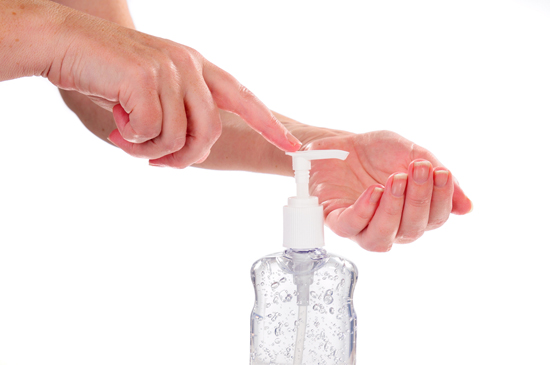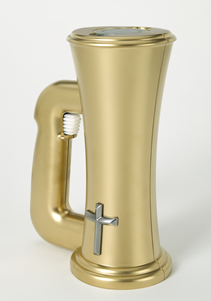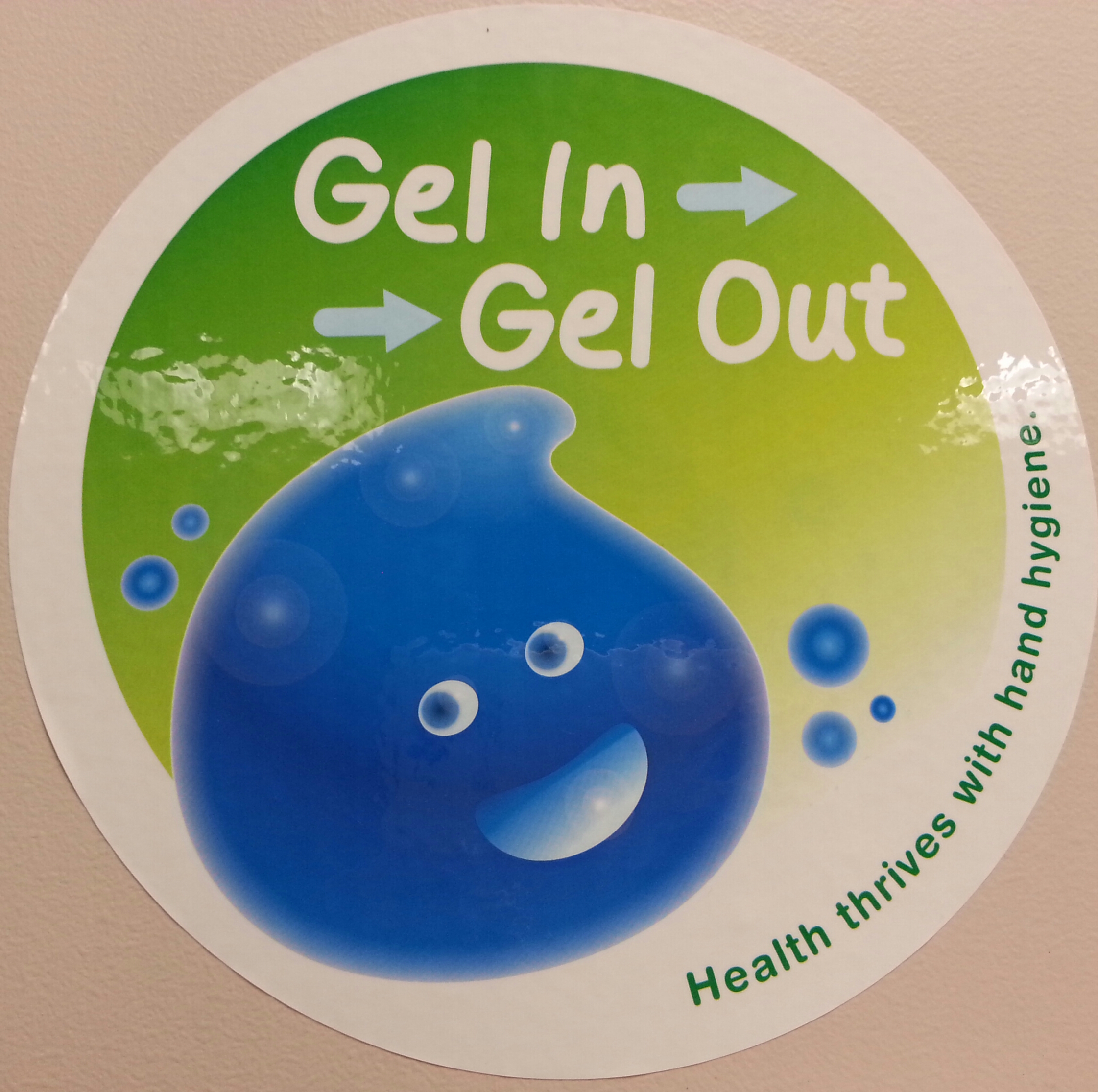Gel in or gel out? Questioning the new 'ritual' cleansing at Communion
 Hand washing by ordinary and extraordinary ministers of Communion was instituted in 2009 with the worldwide outbreak of Swine Flu. Gelling up prior to the distribution of Eucharist served as a precaution to spreading the epidemic of a very serious virus that was a descendent to the pandemic influenza virus of 1918 that affected 500 million people across the world and responsible for the death of 50-100 million, (often healthy young adults), which equaled 3-5% percent of the entire world population. The 1918 epidemic lasted for two years.
Hand washing by ordinary and extraordinary ministers of Communion was instituted in 2009 with the worldwide outbreak of Swine Flu. Gelling up prior to the distribution of Eucharist served as a precaution to spreading the epidemic of a very serious virus that was a descendent to the pandemic influenza virus of 1918 that affected 500 million people across the world and responsible for the death of 50-100 million, (often healthy young adults), which equaled 3-5% percent of the entire world population. The 1918 epidemic lasted for two years.
When Swine Flu reared its ugly head in 2009, public health agencies became nervous that this strain of influenza would once again take a toll in a really big way on the internationally community. As a result, a push on hand washing was adopted as a safety measure by public health agencies and adopted by many institutions on behalf of safeguarding people. The Catholic Church was no exception and instituted the practice of hand washing before the distribution of Communion.
 communion wafer dispenserFive years later, the practice of "gelling up" by the extraordinary ministers of Communion appears to have become a ritual exercise as part of the Fraction Rite. In a recent on-line conversation with liturgical leaders, one shared that he was asked by a member of the worshipping community to sanitize his hands after he shares the Sign of Peace to avoid the spread of germs that might come from the altar. Another has experienced Communion ministers standing around the altar with their hands "raised in a communal slathering gesture," and listened as some communicants shared that the scent of the gel liquid that remains on communion ministers' hand smells unpleasant and may even taste unpleasant if that scent leaks on the altar bread. (For people undergoing particular medical treatments, this can actually make them sick because of their heightened sensitivities.)
communion wafer dispenserFive years later, the practice of "gelling up" by the extraordinary ministers of Communion appears to have become a ritual exercise as part of the Fraction Rite. In a recent on-line conversation with liturgical leaders, one shared that he was asked by a member of the worshipping community to sanitize his hands after he shares the Sign of Peace to avoid the spread of germs that might come from the altar. Another has experienced Communion ministers standing around the altar with their hands "raised in a communal slathering gesture," and listened as some communicants shared that the scent of the gel liquid that remains on communion ministers' hand smells unpleasant and may even taste unpleasant if that scent leaks on the altar bread. (For people undergoing particular medical treatments, this can actually make them sick because of their heightened sensitivities.)
One of the most extreme "cautionary" measures can be seen on a YouTube about Purity Communion Solutions. A dispenser completely eliminates human contact with consecrated bread. The video shows a Communion minister clicking the handle into the recipient's hand. No touch, no germs, no risk of disease. A Communion minister adjacently holds a tray with mini-cups that contain pre-dispensed individual portions of the Precious Blood. No danger of human contact there. Step right up and help yourselves, folks. We deliver Jesus, not germs.
A health care provider's perspective
 "Gel in and gel out" is a common phrase among health care providers who care for the sick. All clinicians and staff who come in contact with patients are trained to wash their hands as they enter the presence of a patient and leave a patient within the patients' visible eyeshot. Patients are even encouraged to remind their health care providers to wash their hands if a clinician should happen to forget to gel in.
"Gel in and gel out" is a common phrase among health care providers who care for the sick. All clinicians and staff who come in contact with patients are trained to wash their hands as they enter the presence of a patient and leave a patient within the patients' visible eyeshot. Patients are even encouraged to remind their health care providers to wash their hands if a clinician should happen to forget to gel in.
"We care about you and take reasonable approaches to prevent the spread of infection," one health provider told me. "The Center for Disease Control and Infection provides guidelines, education strategies and a myriad of resources that assist health care providers insure the public's safety. Hand hygiene reduces the risk of infection and disease. During the flu season, which lasts from October 1 through March 31, care givers are mandated to either get a flu shot or wear a face mask for reasons of patient safety and the prevention of infectious disease."
Liturgy is not meant to be safe
As much as I appreciate and agree with the rationale behind hand washing and the reasonable expectations of the CDC and the people who care for the sick, liturgy is not meant to be safe. Liturgy is dangerous. Liturgy is demanding. The very act of sharing Eucharist is an act of faith, not only in spiritual practice but as bodily persons who give ourselves entirely over in trust and surrender to the Paschal Mystery. When we blithely invoke the Holy in sacramental worship, do we really believe in the power of grace that protects, heals and strengthens? Or are we just pretending to believe and gelling in and worse, gelling out to lead sterile, conditioned and comfortable, safe lives? Adding sterilization rituals to its liturgical form diminishes the very nature of what the celebration of Eucharist requires of us as disciples of Jesus Christ.
A perfect time
Flu and cold season will officially end during the season of Lent. What a perfect time for leaders of worship to restore the original Fraction Rite without a gel ritual in practical and at the same time thought-provoking ways. This paragraph from Constitution of the Sacred Liturgy provides the basis of such catechesis:
"It is very much the wish of the church that all the faithful should be led to take that full, conscious, and active part in liturgical celebrations which is demanded by the very nature of the liturgy, and which the Christ people, 'a chosen race, a royal priesthood, a holy nation, a redeemed people' (1Peter 2: 9, 4-5) have a right and to which they are bound by reason of their Baptism. SC #14
All the elements are right there. Our ancestors in faith (who probably did not use cleansing gel) fully, actively and consciously accompanied the elect throughout their process of Christian initiation to the font and beyond. We continue their practice of praying, fasting and giving alms throughout the season of Lent. Perhaps a parish bulletin that reads, "What are you giving up for Lent?" could read, "Let's give up gel for Lent," and plunge a parish into a counter-cultural understanding of the real challenge that confronts us when we celebrate the Eucharist.
 Believe it or not
Believe it or not
Let's face it: germs exist. No one likes to be sick and no one wants to see anyone become sick. But believe or not, common sense is not so common. What we sometimes presume people know, they have no idea. So educate them. Here are a few helpful suggestions.
1. People transmit more airborne germs just by being surrounded by bodies of worship. Remind people that sneezing and coughing in a closed space like a church will transmit germs. Ask folks to sneeze and cough into their elbows instead of their hands.
2. Invite people to refrain from physical contact at the Sign of Peace if they are sick. Handshakes (and beyond) at the Sign of Peace are far more likely to pass seasonal viruses than the distribution of Communion sans gel.
3. Ask people to abstain from receiving Eucharist on their tongue and abstain from sharing the communal cup that contains the Precious Blood when they're sick.
3. Stay home when you're sick. The only way to recover from a cold or virus is to drink plenty of fluids, stay in bed and rest. Tell people to stay home from Sunday worship if they're sick. That's when a ministry to the sick can kick in. If you're fortunate enough to have a parish nurse team, ask health care providers to check on missing members from Sunday worship, especially the elderly. Bring the Eucharist to the homebound. Deliver soup and foodstuffs from the ministry of hospitality. This is the way to be Church.
4. Ask communion ministers (both ordinary and extraordinary) to refrain from distributing the Eucharist if they are sick. That's a common courtesy that people will very much appreciate. Find a substitute to replace you and practice self-care. That's good ministry.
5. Start a conversation throughout this Lent and Easter with your worship communities about how our personal challenges, the dangers of our world and the wellness of family and friends can keep us in a perpetual state of fear that can even lead to obsessive frenzy. What does our worship say to people about what we believe as disciples of a man who was so subversive that they murdered him when we attempt to sterilize ourselves as a result of fear? (Hello, Christians.)
A false confidence
Gelling up before we distribute the source and summit of our faith is a superfluous action that gives people false confidence in that sacrament. You cannot package sacred mystery in a bottle of cleanser. Presence - our full, conscious and active presence, even when it's dangerous is the Gospel at work. Do we have the courage to change a five-year-old cleansing practice that has now become part of a sacred ritual?
Gel in or gel out?
Thoughts and comments welcome.
 Denise Morency Gannon
Denise Morency Gannon
Reader Comments